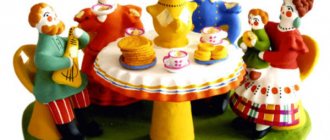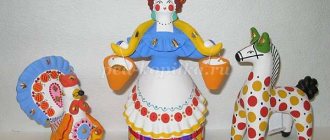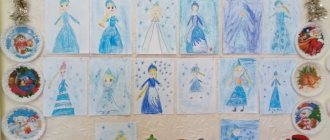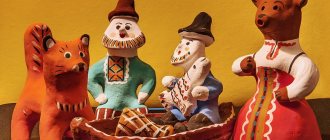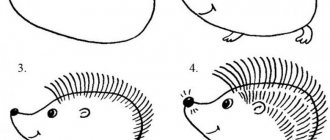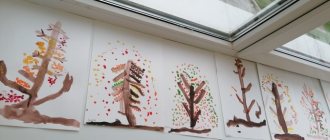Project in the middle group of a preschool educational institution. Dymkovo toy
Project “Acquaintance with the Dymkovo toy.” Middle group
Description : this project was developed for children of middle preschool age, it can be useful for kindergarten teachers. Project goal: Formation and development of the foundations of the spiritual and moral culture of children through familiarization with folk crafts - Dymkovo toys, painting. Objectives: Educational: - To introduce the Dymkovo toy and the elements of Dymkovo painting. — To develop the skill of using drawing materials. — Teach to see the beauty of the Dymkovo toy. — Develop artistic taste as a result of making crafts. Developmental: -Develop cognitive activity, visual memory, attention, curiosity. — Develop artistic taste as a result of making crafts. — Develop hand motor skills and fine finger movements. — Develop all components of coherent speech, its grammatical structure, dialogical speech, social and linguistic competence, and communication skills. Educational: - To cultivate a love for folk crafts and folk art. — Cultivate respect for the work of masters. Type of project : educational - creative. Project duration : short-term Project participants : educators, parents, middle school children. Relevance : The Dymkovo toy is a Russian folk toy that has firmly entered the everyday life of preschool institutions. It’s hard to imagine a more “childish” toy. Dymkovo toys attract children with their brightness and originality. These products delight the eye, lift your spirits, and reveal the world of a joyful holiday. Decorative drawings of Dymkovo toys are simple but original; they are naive but expressive. Decorative drawing of Dymkovo toys gives children the opportunity to feel themselves in the role of an artist - decorator, to reflect in their work an aesthetic vision and feeling of the beauty of the surrounding world and nature. Expected result : during the implementation of this project, I assume that as a result of the joint activities of pupils, their parents and the group teacher, children will develop an interest in the Dymkovo toy. They will learn the colors of this painting and be able to name all its elements. Learn drawing techniques and learn how to make patterns. Children will get an initial understanding of decorative and applied arts and expand their horizons with the help of poems, riddles, and games. Parents of students will show interest in implementing the project and will use it at home. Project implementation plan : 1. To interest people in Russian folk culture using the example of getting acquainted with the Dymkovo toy. 2. Preparatory stage: - Select and study literature about the history of the Dymkovo fishery and its current state. — Creation of the necessary conditions for the implementation of the project. — Development and accumulation of methodological aids for getting acquainted with Dymkovo painting. 3. Main stage (practical): - Introduction into the educational process of effective methods and techniques for developing preschoolers’ knowledge about the Dymkovo toy. — Implementation of the project through various types of activities: holding conversations with children, reviewing manuals, artistic and creative activities, conducting didactic and board games, learning poems, nursery rhymes, guessing riddles on the topic. 4. Final. — Exhibition of drawings on the topic, crafts. -Organization of consultations for parents “The role of folk toys in the upbringing of preschoolers” - Organization of an exhibition of joint works of parents and children “The Beauty of the Haze”. — Quiz for parents and children “Dymkovo Toy Factory.” Product of project activities: Didactic games, coloring books “Dymkovo toys”, replenishment of the Dymkovo toy collection, exhibition of handicrafts “The Beauty of Dymka”.
Progress of
the GCD project. Cognition. Goal: To consolidate the ability to examine, describe and compare folk toys. To develop knowledge about the features of painting toys, color, and the main elements of the pattern. To cultivate interest, respect and respect for folk art. 1. Topic: “Introduction to the Dymkovo toy.” 2. Topic: presentation “Merry Haze”. 3. Topic: guess the riddle “Beautiful Haze”. Communication. Purpose: Examination, comparison and description of objects. Formulating statements and independent judgments, drawing up proposals. React emotionally to the story, ask questions. 1. Topic: conversation “Features of painting Dymkovo toys.” 2. Topic: reading poems about the Dymkovo toy. 3. Topic: guessing riddles about Dymkovo toys. 4. Topic: learning poems about haze. Artistic creativity. Purpose: Examination of Dymkovo toys, study of details and features of the ornament. Participate in a conversation about color and rhythm in a pattern. Completing the task according to the sample. Independent choice of color for the pattern and composing a pattern from familiar elements. Develop fine and gross motor skills of the hands. 1. Topic: “Dymkovo toy” (coloring with pencils according to the proposed sample). Coloring book of children's choice. 2. Topic: “Patterns of Dymkovo toys” (drawing some patterns with gouache). 3. Topic: “Decoration of plates with Dymkovo patterns” (applique with drawing elements). 4. Topic: “Decorating a dress with Dymkovo patterns” (drawing). Educational games. Goal: enrich children's vocabulary. Develop coherent speech, attention, thinking. Consolidate knowledge about the Dymkovo toy. 1. “Dymkovo Lotto”. 2. “Find the same pattern.” 3. “Assemble a pattern.” 4. “Put the whole thing together.” Musical and artistic activities. Goal: to develop in children an interest in folk music and a desire to listen to it. Evoke emotional responsiveness. 1. L. Volokitina “Fair”. 2.Russian folk song “Berry”. 3. Russian folk song “Barynya”. 4. Russian folk song “We lived with grandma.” 5. Russian folk song “There was a birch tree in the field.” Outdoor games. Goal: to introduce children to folk games. Develop the ability to act in a team. 1. "Stream". 2. "Burners". 3. “The shoes are lost.” 4. "Tug of war." 5. "Golden Gate". Literature. 1. Vokhrintseva S. Learning to draw.
Dymkovo toy – 1. Didactic demonstration material for organizing visual activities for kindergarten and primary school programs. Publishing house "Fantasyland". 2. Vokhrintseva S. Learning to draw. Dymkovo toy – 2. Didactic demonstration material for organizing visual activities for kindergarten and primary school programs. Publishing house "Fantasyland". 3. Vokhrintseva S. Coloring book “Dymkovo toy”. 4. School of the Seven Dwarfs. Painted toy. For classes with children from 4 to 5 years old. 5. Tikhonova M.V., Smirnova N.S. Introducing children to Russian folk art, crafts, and everyday life in the kindergarten museum. St. Petersburg Childhood – Press, 2000. PHOTO REPORT
“Dymkovo toy” (coloring with pencils according to the proposed sample)
“Patterns of Dymkovo toys” (drawing some patterns in gouache)
“Decoration of a plate with Dymkovo patterns” (applique with drawing elements)
“Decorating a dress with Dymkovo patterns” (drawing)
"Gather the Whole"
Russian folk game "Golden Gate"
Outdoor games
We recommend watching:
Lesson with older preschoolers. Dymkovo toy Lesson notes on labor training in 2nd grade Notes of GCD in the middle group. Dymkovo toy Summary of the lesson “Dymkovo toy” for children of the preparatory group
Similar articles:
Modeling figures from plasticine
Master class for preschool teachers. Dymkovo lady
Lesson notes for the middle group. Dymkovo toy
“Just as there is no man without self-love, so
There is no man without love for the fatherland, and this love
gives education the sure key to a person’s heart..."
K.D.Ushinsky
Relevance of the project:
Currently, children have a poorly developed cognitive interest in the folk toy and its history, because store shelves are overflowing with a variety of foreign-made toys, and information systems actively advertise them. Parents practically do not buy traditional toys for modern children. The centuries-old experience of mankind has shown the importance of introducing children to the culture of their people, since turning to the paternal heritage fosters respect and pride for the land on which you live. Therefore, children need to know and study the culture and traditions of their ancestors. If a child is not introduced to folk arts and crafts in preschool childhood, then full familiarization with the history and culture of his people will not be achieved, which will subsequently lead to the impoverishment of his moral and patriotic feelings. It should be noted the role of folk toys in the process of teaching preschoolers almost all types of children's activities.
Project goal: Introducing children to folk culture through familiarization with folk toys .
Project objectives:
- To arouse a desire in children to get acquainted with the variety of folk toys (clay, wood, rag, straw, birch bark, etc.)
- Ensure memorization of games with folk toys, the possibility of using them in various types of children's activities (moving, plot, director's games, theatrical activities, visual arts based on folk toys)
- To promote the development of cognitive interests, aesthetic perception, logical thinking, attention, imagination, sensorimotor skills, dexterity, ingenuity.
- Form and develop communication skills, the desire to use folk toys in joint and independent activities.
Project type:
By the nature of the subject area: Socialization
Composition : group
By average duration (03/20/13-03/31/13)
The participants of the project are middle preschoolers, teachers of the institution, and parents.
Estimated results of the project:
- Knowledge of various types of folk toys and the content of games with them
- The ability to organize joint and independent play activities with folk toys
- A persistent desire to play with a traditional toy
Form of the final event: Evening of entertainment “Visiting grandma - Zabavushki”
Intended product of the project: Exhibition of creative works of children.
Project implementation scheme
| STAGE | Integration of educational areas | Joint activities of adults and children, taking into account educational areas | Developmental environment | Working with parents |
| preparatory | Survey of children (Appendix) Conversation about the lives of children in the past, their activities, games, toys. Conversation about the work of adults creating objects of decorative and applied art. Examination of illustrations about the life of children in the past. | Selection of Russian folk tales Selection of didactic games Albums “Folk Toy”, illustrations about decorative and applied arts. Articles on the topic “Where did the first toys appear in Rus'”, “All about folk toys”, | Joint holidays “Holidays of the national calendar” (Maslenitsa) Visual propaganda, mobile folders. | |
| basic | Conversations “Why do we need toys?” “Who makes them?” “How should you handle toys?” Experiments-comparisons of wooden, clay and hair toys (Heavy - light, cold - warm) GCD “Visiting the Magpie” Theatrical game “Turnip from a nesting doll” Riddles about folk crafts Learning rhymes, poems, proverbs, fables, D. game “House for nesting dolls” (correlation by size; with design elements) “Which doll is hidden?” “Describe the toy” “Arrange the nesting dolls by size” Finger games “Matryoshka”, “Dymkovo ladies” Physical education minutes Breathing exercises “Admiring the toys, Ducky, Blowing, Blowing” Russian folk outdoor games “Rasteryakhi”, “Lark”, “Dudar”, “Geese-geese”, “Golden Gate”. Role-playing game “Toy Store”, “Let’s Go to the Museum” Develop skills in safe handling of scissors. Cultivate a caring attitude towards things. Expand your understanding of how to safely handle clay and porcelain toys. Let's put things in order on the shelves. Fostering a positive attitude towards work. Drawing GCD “Dymkovo Horse” Application “Let’s Decorate the Matryoshka Dolls” Construction “Toy Store” Learning ditties Round dance game “The lark sang in the sky” Dance “We are nesting dolls” Orchestra of folk toys | Examination of Illustrations of a variety of folk toys Illustrations in books Exhibition of folk toys | Consultation for parents “The role of folk games and toys in the education of preschool children” Information and poster materials “How to sculpt a whistle” “How to make a doll” | |
| final | Evening of entertainment “Visiting grandma - Zabavushki” Goal: Introducing children to the origins of Russian folk culture. Exhibition of children's creative works. | Parents are involved in preparing the entertainment. |
Conclusion: The project achieved its goals and objectives. Many warm words were said about the project by parents. They noted that the children learned a lot of interesting things about folk crafts, gained experience playing with folk toys,
using them in independent activities,
they began to share their impressions with family and friends. They have a desire to independently acquire knowledge; children actively engage in communication and are able to defend their point of view.
APPLICATION.
Survey of children
18 children took part.
Do you know how to play with it?
Conclusion: Analyzing the results obtained, we can conclude that most children have no idea what toys they played with before. And 28% of children have no idea how and what they can play with a folk toy.
Survey of children
18 children took part
Conclusion: At the beginning of the study, a lack of knowledge among children about the history of folk toys was revealed; in addition, many of the children had no idea how and what to play with folk toys. However, after a short story about the toys that were played in the old days, and the play activities held, the preschoolers still became interested in this issue, learned a lot of new things for themselves, helped prepare play material, and passed on the information to others.
